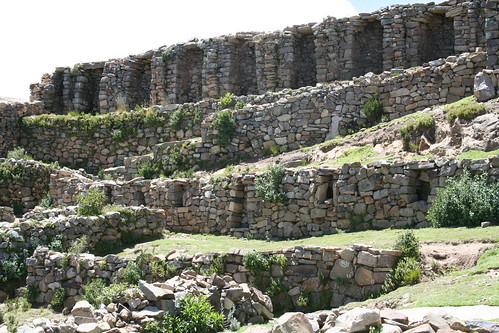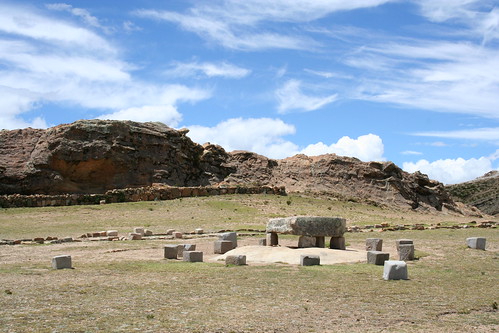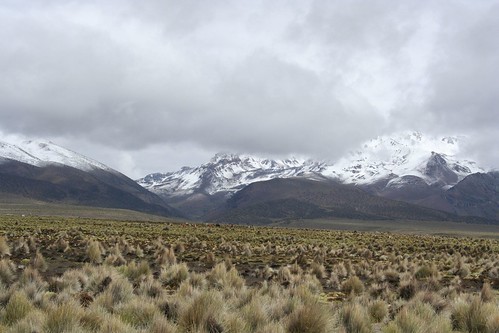Lake Titicaca: 3/22-28/2007
The old Aymara man pulled again to start the outboard. Then again. And again. We are slowly drifting away from the small dock of the Isla de la Luna, Lake Titicaca, Bolivia. The wind is picking up, and if this motor doesn’t start soon, we are going to be out in the middle of this sea-size lake in no time.
We hired a boat to take us from a little town on the north end of the Isla del Sol to the ruins of an Inca priestess monastery on the island of the moon.

We have just spent two days on the island of the sun, and visiting the sacred island of the moon before returning to Copacabana, on the mainland, balances our experience here. What an incredible trip and trek! This beautiful lake, with its islands, sheep, and little boats docked in small blue harbors, feels much more like the Mediterranean sea than a freshwater lake at 12,000+ feet.

Titi Khar’ka means ‘Rock of the Puma’, this massive lake is named after the sacred rock…Titicaca. Legend has it that the entire lake originated by, or was filled by, three sacred springs called Fuente del Inca. The early Tiahuanaco culture, then the Kollas people (also called Aymara, who are still here today), and the Inca, thought the lake sacred, as the birthplace of the Sun and Moon. The Sun-god and Moon-goddess were both born out of the Rock of the Puma. Then the Sun-god rose into the sky from the Isla del Sol, and the Moon-goddess rose into the sky from the Isla de la Luna. The ancient town on the mainland, Kota Kahuana, Copacahuana, or most currently Copacabana, has been a resting site for pilgrims visiting the huaca (shrine) at Titi Khar’ka (Rock of the Puma) for thousands of years. The shrine, the sacred rock, and the springs are all on the Isla del Sol, or Island of the Sun. From the time of pre-Incan Tiahuanaco culture, through the Incan Empire, for the early Spanish colonialists, to the present, people from all over South America and the world have made pilgrimages to the Isla del Sol. This tiny island, with it’s small spring in the South, and its unremarkable looking rock and mesa in the North, might be thought of as the western hemisphere’s Mecca. It has the most, and longest, history of spiritual pilgrimage. The early Spaniards believed that the springs were a fountain of youth. Still, current pilgrims to the spring drink a cup of water from each of the fountains, or pour it over their heads for its healing properties. The ceremonial table huaca at the Rock of the Puma was used for sacrifices and rituals with the four directions. Pilgrims walk the length of the island, from the springs to the rock, to make their offerings and meditations at the birthplace of their culture.
A few days ago, we approached the town of Copacabana from the east. At the Tiquina Straits, we hired a barge to ferry our car across, then continued into town, arriving after dark.

When we looked out the hotel window in the morning, we caught our first view of the crystalline blue, sparkling mystical waters of this beautiful beautiful lake. We spent the morning preparing for our pilgrimage to the Isla del Sol and Isla de la Luna, and enjoying a formal parade of school children down the main street to the lake (it was a national holiday). Then we hiked down the road to check out some Inca ruins 45 min away.

Rod rested from the walk in the nice chair carved by the Incas for him to sit in. The next day, with full packs, we caught the midday ferry to the Isla del Sol. We were dropped off at the foot of the escalera del Inca.
The spring is at the top of a long Inca stairway that leads from the beach 205 steps (some dispute over this number, but I counted the steps when I walked up the stairs and I got 205) up to the stone fountain built by the Incas.

The fountain has three spouts, each supposedly fed by an individual spring. The two outer spouts represent polarity and balance, male and female, the sun and moon. The center spout represents the center of all things, the universal energy. Interestingly when we were there, there was no water running from the outer left fountain, the female fountain, or the balance to the male energy in the world.
The next morning we began our walk to the Rock of the Puma on the north end of the island. We strayed from the Inca road periodically in order climb to the summit of each of the islands’ small peaks. Finally we reached the sacred rock and the ceremonial table to it’s south.

Next to the table is a mesmerizing ruin called ‘the labyrinth’. It is a maze of rooms and courtyards with a natural spring inside and running through it. It is said that this was an Inca monastery and seminary.

We bivied/camped just down hill from the labyrinth, above a shining blue bay. As we enjoyed a mac’n’cheese dinner and watched the sun set over the bay, birds dove for fish and not a boat or light could be seen.

We were struck by the silence and simple peace of this old place. Falling asleep, I enjoyed a spectacularly starry sky, and got a little creeped-out imagining Inca priest ghosts walking out of the ruins.
In the morning we rose early to sit in each of the direction-chairs at the ceremonial mesa, then watch the sun rise over the Rock of the Puma and the mesa. It was magical. Some sheep joined us just after sunrise.

We packed up and walked an hour into town for breakfast. After eating and getting a couple sandwiches for lunch, we boated out to Isla de la Luna.
The Isla de la Luna is much less visited than the Isla del Sol. The small community on the island jumped when they heard a boat coming. They assaulted us with souvenir buying opportunities from the moment we docked to when we walked out of the town toward the ruins.

The birthplace of the Moon has an odd polarization… it is better preserved and protected than other ruins, but it had an odd feeling of disregard and unappreciation, especially compared with the birthplace of the Sun. This monastery was inhabited by priestesses on the island of the goddess Moon – this is THE we-moon site. Is it appropriate social commentary that the female balance to the male is so off kilter? The critical balance of the sacred male and female of the “old” or native world is not mirrored in today’s dominant societies. Is this inequality at the base of the disturbance in today’s culture? It is certainly manifest in the western hemisphere’s Mecca.
With these thoughts spinning around in our minds, we stepped off the island back into the boat and pushed off….

floating out into the blue clarity as the kind old driver pulls again to start the motor.

 As we walked through this space, feelings of peace and power were clear. However, our tour was punctuated by the crude and comedic efforts at protecting the important pieces.
As we walked through this space, feelings of peace and power were clear. However, our tour was punctuated by the crude and comedic efforts at protecting the important pieces.  Harsh barbed wire surrounded many of the sculptures, and we were yelled at periodically by the archeologists for taking pictures of them, and I don’t know what else… being there I suppose.
Harsh barbed wire surrounded many of the sculptures, and we were yelled at periodically by the archeologists for taking pictures of them, and I don’t know what else… being there I suppose. 


 When we looked out the hotel window in the morning, we caught our first view of the crystalline blue, sparkling mystical waters of this beautiful beautiful lake. We spent the morning preparing for our pilgrimage to the Isla del Sol and Isla de la Luna, and enjoying a formal parade of school children down the main street to the lake (it was a national holiday). Then we hiked down the road to check out some Inca ruins 45 min away.
When we looked out the hotel window in the morning, we caught our first view of the crystalline blue, sparkling mystical waters of this beautiful beautiful lake. We spent the morning preparing for our pilgrimage to the Isla del Sol and Isla de la Luna, and enjoying a formal parade of school children down the main street to the lake (it was a national holiday). Then we hiked down the road to check out some Inca ruins 45 min away. 

 Next to the table is a mesmerizing ruin called ‘the labyrinth’. It is a maze of rooms and courtyards with a natural spring inside and running through it. It is said that this was an Inca monastery and seminary.
Next to the table is a mesmerizing ruin called ‘the labyrinth’. It is a maze of rooms and courtyards with a natural spring inside and running through it. It is said that this was an Inca monastery and seminary. 










 After breakfast, we walked to the base of the climbs, watched the military demonstrations for a while, and decided that we didn’t want to be climbing right in the middle of it all. Our luck… this ceremony happens once a year and we chose this exact date to climb here!! We went off to an area to the side and set up ropes to practice crevasse rescue and glacier travel skills. We stayed until the afternoon, then decided to come back to climb another day.
After breakfast, we walked to the base of the climbs, watched the military demonstrations for a while, and decided that we didn’t want to be climbing right in the middle of it all. Our luck… this ceremony happens once a year and we chose this exact date to climb here!! We went off to an area to the side and set up ropes to practice crevasse rescue and glacier travel skills. We stayed until the afternoon, then decided to come back to climb another day. During dusk and dawn the quiet peace is consistently broken by the loud squawks of the three nesting Condors in the cliff band. And, as we walked along the top of the cliffs in the afternoon, we were surprised to find that we were being studied for a while by a wise silent owl.
During dusk and dawn the quiet peace is consistently broken by the loud squawks of the three nesting Condors in the cliff band. And, as we walked along the top of the cliffs in the afternoon, we were surprised to find that we were being studied for a while by a wise silent owl.
